Dzire vs Tigor vs Xcent vs Ameo vs Amaze vs Aspire comparison
It’s the big fight of the small sedans. We brought together all the petrol manual compact sedans to pick the one car that does it all.
Published on Aug 11, 2017 02:41:00 PM
1,22,369 Views
Follow us on



We’re halfway into 2017 and have already witnessed the arrival of the Ford Aspire Sports Edition, the new Tata Tigor, the facelifted Hyundai Xcent and the new Maruti Dzire compact sedans. Interestingly, the spate of launches comes at a time when demand for compact sedans is on a decline. Private buyers are slowly shifting preference to compact SUVs and large hatchbacks, and whatever growth there is in the segment, it’s coming from cab aggregators. Can the new launches bring the attention back to the much-loved sub-four-metre sedan?
The answer is a big yes, if you look at the response to the new Dzire. Maruti has received over 50,000 bookings for the new Dzire (no longer called the Swift Dzire) and the waiting period is already up to a couple of months at some places. On sheer popularity then, the Dzire is the car to beat. Tata’s weapon for the job is the Tigor. True, the Tigor is actually from a sub-segment below the others and is significantly cheaper too, but the lack of any direct competition means it can be clubbed together with the, well, big boys. In case you are wondering why we left out the capable Tata Zest, it’s because the model is destined to become a cab-only product in the months to come; and that’s a shame.
Hyundai has plans to do a taxi-only version of the base Xcent as well, but what we have here is the facelifted car that gets a bit more equipment and a few suspension tweaks. Volkswagen’s Ameo seeks to impress with its solid build, while the Honda Amaze is relying on its practicality to take on the others. Last but not least, we have the well-rounded Ford Aspire. Unfortunately, Ford didn’t have the new Sports Edition version for us to test. Cosmetic updates aside, the Sports Edition gets larger wheels and a reworked suspension for enhanced driving dynamics.
For this comparison, we’ve taken the top-spec petrol manual versions of these compact sedans. What we are interested in is tofind the car that offers the right blend of performance, practicality, efficiency and ease of use, in one wholesome package.
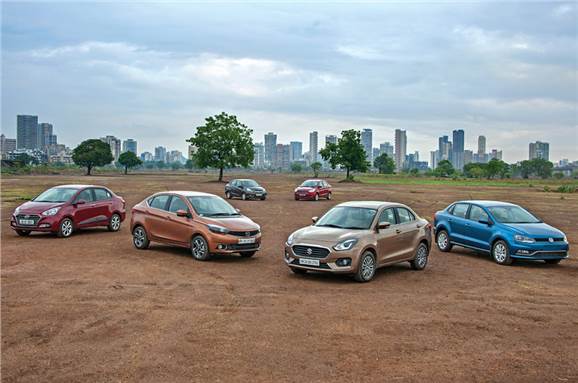
Design & engineering
New Dzire is far better proportioned than old car. Tigor shape is unique while Xcent looks smaller than most rivals. Ameo’s truncated rear looks odd but the VW is the best built. Aspire has its good angles. Amaze is pleasant but has the lightest build.
With the shortest of these compact sedans measuring 3,990mm in length and the longest ones measuring 3,995mm, these models are just a hair’s breadth inside the tax-friendly, four-metre cut-off for ‘small cars’. Near identical in length they may be but these cars do differ in height and width. In a nutshell, the Ameo is the lowest, the Tigor is the tallest, the Xcent is the narrowest and the Dzire is the widest. The new Maruti also happens to be the lightest of these compact sedans, tipping the scales at just 895kg, a full 70kg down on the last-gen Swift Dzire petrol.
Visually, the new Dzire is a clear departure from the old one, with a far more balanced three-box shape and smoother, curvier lines on the body. This time around, though, it’s not the tail but front-end styling that may need some getting used to. The peeled-back headlamps and chrome-lined hexagonal grille are not to all tastes.
Where Maruti’s designers have strived to give the third-gen Dzire a conventional sedan look, Tata’s designers have opted for a far more unconventional look for the Tigor. The manner in which the roofline flows into the short rear deck is unlike any other compact sedan. The Tigor shares its platform with its hatchback sibling, the Tiago, but the wheelbase has been extended by 50mm here. It has a pleasing face that only differs to the Tiago’s in its use of smoked-effect headlights and projector lenses.
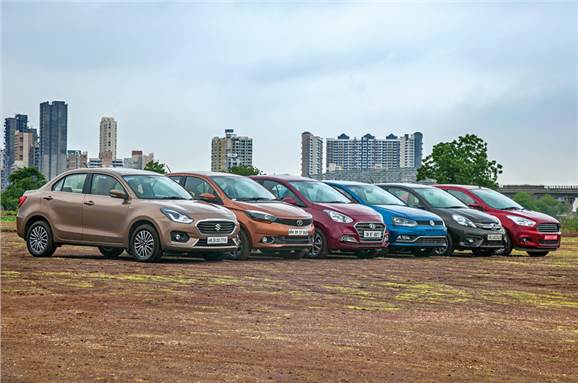
Hyundai, on the other hand, has used the recent round of facelifts on the Grand i10 and Xcent to steer away from that ‘identical twin’ look. The Xcent has got the more dramatic makeover with a large, almost oversized, cascading grille leading the list of changes. Significantly larger, new tail-lights also help give the Xcent a relatively fuller look at the rear, but the Hyundai still appears narrower and smaller than rivals.
The Volkswagen Ameo has its own image problem. It looks like a Polo hatchback with a boot tacked onto it. Then again, that’s actually what it is. The Polo was not designed to spawn a compact sedan body style but the burgeoning demand for such cars in our market had Volkswagen do a made-for-India model that eventually took shape as the Ameo. The squared-out boot looks truncated and, as a result, the proportions seem off. There’s a strong Germanic vibe to the rest of the car, and that's quite appealing though.
The Amaze, which was originally launched in 2013, is the oldest car here. But Honda slapped on even more chrome on the grille and tacked on new front bumpers in 2016 to keep its small sedan looking fresh, and the exercise did prove worthwhile. Today, the well-proportioned Amaze looks inoffensive, if not really eye-catching.
The Ford Aspire, in contrast, has a bit more star appeal. That Aston Martin-like grille is attractive and the front-end does look nice, more so in certain colours. It has the longest wheelbase here, but when combined with a stubby boot, this is clearly not a smooth-flowing design. The Aspire’s small 14-inch wheels also appear dwarfed amidst the large body. The Aspire Sports Edition, however, runs 15-inch alloys and looks all the better for it.
Interiors
Dzire and Amaze are the roomiest, Ameo is most cramped. Aspire has best seats while Xcent’s are so-so. Tigor surprisingly comfy for its size.
Driver environment
Anyone familiar with the old Swift Dzire’s cabin will immediately note how much larger and airier the all-new model is on the inside. The new Dzire gets a smart-looking, two-tone dashboard, with a 7.0-inch touchscreen taking pride of place on fully equipped ‘+’ models. Other things to like include the classy hooded dials and the large and supportive, if slightly soft-cushioned, front seats. However, quality hasn’t taken as much of a step up as we had hoped for. The plastics are hard and some buttons can be traced back to the original Swift of 2005! Also, the faux wood on the dash and sporty flat-bottomed steering is passé in our opinion.
Tata on the other hand, has gone to great lengths to up its quality game. The textured finish on the dash top, the fabric insert on the doors and the knitted roof lining are premium details that transcend the Tigor’s bargain price. But it’s not perfect. You don’t get that sense of solidity on door shut, some plastics lower down feel scratchy and there are inconsistent panel gaps in certain areas, like the glovebox lid. The black and grey interior colour scheme does help hide some of these flaws and also makes the Tigor’s cabin the easiest to keep clean. The driver sits comfortably on the large seat and outside visibility is really good thanks to the neatly laid-out dashboard’s low cowl. A larger, less reflective touchscreen for the infotainment system, however, would go a long way in enhancing the overall look and user experience.
Incidentally, the addition of a large 7.0-inch touchscreen is the big change on the inside of the updated Hyundai Xcent. The screen takes centre stage on the dash and, thanks to it being positioned high up, falls within the driver’s line of sight. In general, the Xcent’s cabin scores high for user-friendliness. The high-set gear lever falls easy to hand, the climate control knobs are nice and chunky and the buttons on the richly finished steering wheel give drivers direct access to the audio, phone, trip computer and voice command functions. Fit and finish is really impressive too. Unfortunately, the Xcent’s front seats feel a size too small and their fixed headrests are too short to provide adequate whiplash protection to taller occupants in an impact.
You do get a pervasive sense of safety and security in the Ameo. The large front seats hold you well, the doors make a reassuring thunk when shut and the impression you get is of being in a car that’s just made from a higher grade of steel. You’d also classify the hard plastics that make up the cabin as ‘long-lasting’ rather than ‘cheap’ while the buttons and switchgear on the simply styled dashboard and flat-bottomed steering are all really good. But for all its quality, the Ameo’s cabin is not spacious. You sit close to the co-passenger, the driver environment is quite confined and the high dashboard also means visibility out isn’t the best. The Ameo’s foldable front armrest (unique in this class) also proves intrusive in its lowest position during gear changes.
As part of last year’s update, the Amaze was granted a new dashboard (shared with the BR-V crossover) and it made a big difference in enhancing the cabin ambience. The thing is, quality is good but not great. Also, there’s no provision for a touchscreen infotainment system and the slider-type control for the air conditioning recirculation adjust is prehistoric. But there are plenty of things to like too. The multi-information display in the dials shows plenty of relevant data and the sporty three-spoke steering wheel is great to hold. The slim front seats, with their single-piece backrests, are also more supportive than they appear.
Top-spec Aspires come with factory-fit leather seats that offer fantastic cushioning and comfort. Note, the fabric seats on lower versions are a touch too soft. Finding a comfy driving position in the Aspire takes some time, but once set, you’ll like the good frontal visibility on offer. The dashboard is similar to what we’ve seen on Fords in the past and, unfortunately, the button-heavy centre console makes its way here too. The old-school, dot-matrix display for the Sync infotainment system and the ordinary-looking instrument console do the cabin no favours either. The knurled knobs for the climate control system are quite nice but overall quality is a mixed bag.
Rear seats
Shifting focus to the rear sections of the cabins, the big surprise is that it’s the new Dzire that provides the most legroom. Maruti has even added a rear air con vent and 12V power socket (à la the Xcent) to pamper rear occupants. However, thigh support is just average and taller passengers could find their heads touching the roof. The Tigor can’t match the Dzire on leg space but it offers more by way of rear headroom, but this comes at the expense of a high-seating position. You sit lower down in a Tigor than the others, which gives you a slightly cooped-up feeling. The Tigor’s rear headrests are fixed but they are large enough for the job. Just remember to be careful while opening the Tigor’s rear door though; the edge of the door juts quite far out.
It’s a bit of a drop onto the Xcent’s low rear seat and its backrest is a touch too reclined, but if there’s an advantage to this it’s that the Hyundai manages to offer the most headroom. Kneeroom is decent but the Xcent is just not wide enough to seat three in comfort. The Ameo’s rear seat is also best for two medium-sized adults only. The seat is nice but headroom and kneeroom are down on all rivals. Also note that, while the Ameo does get a rear air con vent, it is the only model here without a rear armrest.
Rear-seat occupants are well taken care of in the Aspire. There’s plenty of room in the back and the seat’s contours also makes it suitable to sit three abreast. Pity, rear-seat occupants have to make do without dedicated bottle/cupholders. All said, it’s the Amaze that offers the best rear- seat comfort. The Honda runs the Dzire really close on legroom, has the more supportive seats and also has the larger windows. But, the limited headroom could be an issue, as well as the fixed headrests that are small.
Boot
When it’s time to load these cars up with luggage you’ll find that all of them offer enough space for an airport run. Still, it’s the Tigor with the largest boot that holds the most. What helps make full use of the available space is the Tata’s expensive multi-hinge and damper arrangement that opens and shuts the boot, and doesn’t intrude into boot space like the standard gooseneck hinges on the other cars do. Of the others, the Xcent’s boot has the best shape and is the most convenient to load into, the Amaze’s boot is large, the Dzire’s is accommodating enough and the Aspire offers the least usable space. The VW’s boot is larger than its 330-litre capacity would suggest and it’s also the only one to offer the added practicality of a folding rear seat.
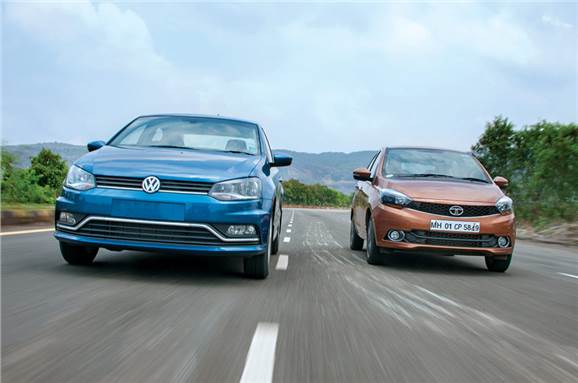
Safety and features
Tigor offers lots for bargain money. Aspire, Xcent and Ameo good on value too. Top Dzires are pricey, and Amaze is expensive for what it gets. Top-spec versions of each get safety essentials but only Dzire and Ameo come with dual airbags and ABS as standard. Top Aspires get six airbags.
Featured in this test are the top-spec versions of all the contenders and all do get a minimum of dual airbags and anti-lock brakes. However, the fully loaded Aspire Titanium+ goes one up on the competition with its six airbags and Emergency Assistance system that can automatically use a paired phone to alert the authorities in case of a serious accident. What’s also noteworthy is that the Dzire is the only car that gets Isofix child seat mounts as standard.
As for creature comforts, auto climate control, steering-mounted audio controls, Bluetooth for telephone and audio-streaming, and USB and Aux are features you’ll find in each of these cars. That said, the Amaze VX (Rs 7.37 lakh, ex-showr00m, Delhi) offers the fewest frills, which comes as a disappointment because it’s not particularly cheap. Tata’s Tigor XZ(O) (Rs 6.04 lakh) is the most affordable car here but packs in more than just the essentials and, as always, it’s the Hyundai (Rs 7.47 lakh) that comes loaded with equipment. The Ameo 1.2 Highline (Rs 7.35 lakh), however, is the surprise package here, boasting of many segment-first features such as cruise control, rain-sensing wipers, reach adjust for the steering and one-touch power windows at the front and rear. The Dzire ZXi+ (Rs 7.90 lakh) is the priciest car in the test, and by quite a margin, but it also comes with the most features, including an auto headlight function and LED projector headlights that provide excellent illumination in the dark. If you are happy to forego some of these features, you could save big money by opting for the far more reasonable ZXi variant (Rs 7.02 lakh).
In the battle of the infotainment systems, the Amaze comes in dead last thanks to its relatively basic audio player. The Ford Aspire does without a touchscreen too, but if you are inclined to make the most of its outdated-looking Sync system, you can pair it to your phone and use a few supported apps through voice commands, like MapmyIndia Explore to get restaurant suggestions, for instance. The Tigor’s 5.0-inch touchscreen is small and not the most responsive to touch inputs, so you’d be better off navigating the menus through the physical buttons and control knobs. Still, the system does offer plenty of functionality. Sync it to your phone and you can use apps for navigation and even a jukebox that allows all car occupants to add songs to a single playlist. Audiophiles take note, the Tigor boasts the best sound system, with its four-speaker and four-tweeter setup delivering a solid punch.
The Ameo’s touchscreen isn’t all that large either but it is functional and comes bundled with MirrorLink. Dzire buyers will be happy to know the car’s SmartPlay infotainment system supports Android Auto in addition to MirrorLink and Apple CarPlay. However, it’s Hyundai’s new 7.0-inch touchscreen that makes the best impression. The system is the nicest to use and also offers multiple smartphone integration options with MirrorLink, Apple CarPlay and Android Auto.
Performance and refinement
Dzire is quickest all around. Xcent is peppy in town. Amaze has mediocre mid-range. Ameo and Aspire offer fair performance. Tigor is slowest. Xcent is best insulated. Dzire and Aspire decently refined while Amaze can get quite noisy. Ameo sounds gruff at times but Tigor is noisiest.
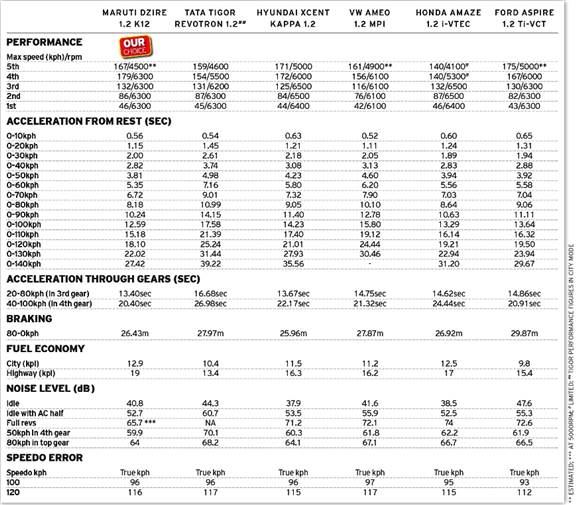
Each of these cars run 1.2-litre petrol engines that come mated to five-speed gearboxes. But where the Dzire, Xcent, Amaze and Aspire use four-cylinder engines, the Tigor and Ameo are powered by three-cylinder units.
Maruti has tweaked the Suzuki K12 unit for use on the Dzire to eke out even more efficiency. Interestingly, the new Dzire’s 83hp power and 113Nm torque figures are marginally down (1.3hp and 2Nm to be precise) to those of the older Swift Dzire. Even so, the Dzire’s substantial reduction in weight more than makes up for the slightly reduced power. Sorry to give in to a cliché, but the new Dzire really does feel light on its feet. Engine responses are good and even at part throttle, the Dzire picks up speed really well. Still, it’s near the 3,000rpm mark that the engine comes into its element, from there on, it’s an exciting pull to the 6,300rpm limiter. Adding to the fun are the Dzire’s short-throw gearbox and nicely weighted clutch. Refinement levels in general are good, with the throaty note from the engine providing a nice soundtrack too.
Unsurprisingly, the Dzire is the fastest to 100kph with a time of 12.59sec. It’s also the quickest through gears two, three and four, with Hyundai’s Xcent holding the minutest of leads in the 80-100kph run in fifth gear slog. The Xcent is a peppy urban commuter in its own right and one you’ll like for its energetic initial responses. Its zingy bottom-end, smooth gearbox and light (albeit short-travel) clutch make it well-suited to Indian city-driving conditions. Ask much more of the 83hp engine and you’ll find the build of power to be fair but unexciting. The Xcent’s motor does make an impression for refinement, with the quietest idle.
Honda’s 88hp 1.2 i-VTEC motor offers Xcent-like initial responses and a Dzire-like exciting top-end. But it’s not quite the best of both worlds. Power fizzles out in the mid-range and you often have to make amends by shifting to a lower gear altogether. The clutch has a nice action but the gearbox isn’t the slickest. Keep to a gear though, with the throttle pressed hard, and, eventually, your patience will be rewarded. The Amaze gets a second wind at 4,500rpm and then revs freely right to 6,400rpm. The top-end is really addictive and you’d want to thrash the engine every once in a while. However, the Amaze comes with a factory-set 140kph speed-limiter, restricting any shenanigans to gears two and three alone. Our sound-testing equipment found the Amaze to be among the quietest cars at idle but also the noisiest of the four-cylinder engine-equipped cars at max revs and on the go.
The Aspire’s engine matches the Honda’s class-leading 88hp power figure but is different in the way it makes its power. The Ford engine is a bit weak lower down the rev range and feels measured in the way it goes about its business. Given that gearshifts require a bit of push and the clutch has a relatively long travel too, the Aspire isn’t in its happy place during the rush-hour grind. However, a fairly strong mid-range does give the Ford some much-needed go for when the roads open, and the engine also revs quite happily from the 3,500rpm mark on. Just be ready to make your peace with an audible high-rev whine from under the hood.
Even bigger compromises have to be made with the three-cylinder engine cars here. Let’s talk about the Tigor first. It uses the same 1.2-litre engine as the Tiago hatchback but Tata has added a balancer shaft to cut vibrations. And this has helped as the Tigor’s engine runs smoother than the Tiago’s. But while there are fewer vibrations at idle, you can still feel a bit of a buzz through the pedals, steering and seats. Also, the engine does get quite loud on the move and is responsible to a large extent for the Tata registering the highest decibels at 50kph in fourth gear and 80kph in fifth.
Then there is the matter of performance – the Tigor doesn’t drive like an 85hp car should. Revised ECU tuning has made fuelling cleaner vis-à-vis the Tiago, and progress is noticeably smoother, but the build of power remains unremarkable. Performance in town is decent and the Tigor will keep pace with traffic; but ask more of the engine and it will leave you wanting. Power delivery is flat and the only reason to stretch the engine would be to see the tacho needle glow red (a Tata detail from the Manza’s time). The Tigor is slower than its rivals across the board, and that’s in the more powerful of its two drive modes. Switch from City to the fuel-economy-enhancing Eco mode and performance takes a further hit, though the differences are not as stark in town as they are on the highway. Don’t get us wrong, the Tigor works just fine as an urban commuter, with a light clutch and easy-shifting gearbox. It’s just that in the larger scheme of things, the engine comes across as the weak link in the Tigor package.
In comparison, the Ameo’s three-cylinder engine is more polished and more complete. Sure, the engine makes all of 75hp (the least here) and has to lug the most weight (the Ameo is the heaviest at 1,069kg) but it seems up to the job. Obviously, you can’t expect it to challenge the fastest but the timings reveal it’s not all that much behind its four-pot rivals. Still, the Ameo is best experienced ambling unhurriedly around town. It has the nicest gearshift but the clutch requires fine modulation at low speeds. Where it gets caught out is in refinement; it sounds gruff at low revs and loud and thrummy higher up the rev range. And if you really search for them, you’ll experience mild vibrations at the seat too.
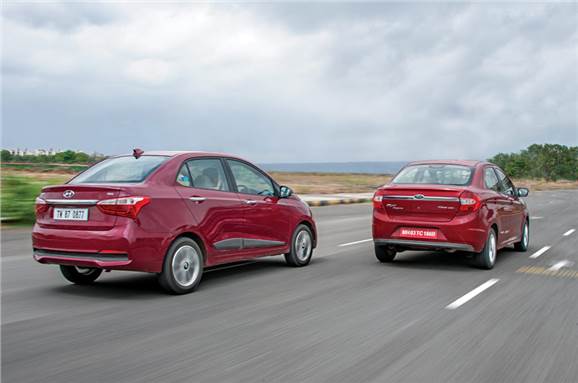
Ride and handling
Aspire best at high speeds, while Xcent comfiest in town. Tigor, Dzire and Ameo offer a good compromise. Amaze can feel choppy at times. Xcent and Amaze have city-friendly controls. Dzire’s steering a let-down. Ameo is a confident handler. Tigor can be fun but Aspire most exciting.
Competent ride and handling were part and parcel of the old Swift Dzire experience. The new car has taken a few steps in the right direction but also a few backwards. Low-speed ride comfort is better, with an added layer of suppleness, making the suspension feel that little bit more absorbent on bad stretches of road. The steering requires less effort to twirl and is light and easy to use. But the steering is irritatingly devoid of feel, lacks sufficient self-centering action and feels artificial, almost like that of an arcade machine. You have to keep a firm hand on the wheel to keep the Dzire going in your intended path. On a windy road, though, you do see that old spark. The car’s nose is pointy, turn-in is sharp and it feels nimble, if not quite as tight as the old Swift Dzire. High-speed manners are good but, again, it doesn’t feel as well-tied-down to the road as the old car.
Like all Tatas, starting from the Zest, the Tigor offers a really good steering. It feels lightest in town but also weighs up predictably at speed. There’s a well-oiled smoothness to it and that makes it really nice to use. You get a good sense of connection with the car and, even though there is a fair amount of body roll in fast corners, the grippy Bridgestone tyres inspire plenty of confidence. The chunky tyres also complement the suspension to soften the blow on really bad roads. Over really big potholes, there is a bit of road shock that shudders through to the steering wheel, but, on the whole, the Tigor rides well and feels planted.
Hyundai has worked on the Xcent’s suspension on the update, and bump absorption is clearly better. That little bit of firmness you felt on the earlier car is all but gone and there’s a maturity in the way the quiet suspension tackles bumps. Low-speed ride really is now best in class. It’s also as manoeuvrable as a small hatchback, making it all the more suited to city confines. The Xcent doesn’t hold the road as well as the Aspire at speed, but you do get more confidence than before. Even on windy roads, the Xcent feels like an improvement but you are never quite sure of how much steering lock to give.
The Ameo’s suspension offers a good degree of compliance. There is a hint of firmness at low speeds but the suspension makes light work of bad roads. Even high-speed manners are impressive. It feels sure-footed at all times, though there is a hint of more vertical movement than some of the other cars here. Also, while the steering doesn’t bristle with feel, it gives you a good sensation of control at all times.
When you are in the mood for a quick drive, the Amaze can be good fun. It’s got an accurate steering that lets you chuck the light Honda into corners with ease. Drive in such a manner and you’ll find the Amaze’s tyres do give up before its chassis does. In everyday driving scenarios, the Amaze feels well-damped but with a firmness built into the setup. The low-speed ride is a bit sharper than the others and, at high speeds, there is more up-down motion too, but it’s never to the point of being uncomfortable.
That said, it’s the Ford that finds the best balance between ride and handling. The suspension has an underlying firmness but it is also really absorbent and smoothens out imperfections without breaking into a sweat. It’s just that the small 14-inch wheels get swallowed by large potholes, so you have to be a bit more careful on really bad roads. But as you build speed, the Aspire feels really planted and just follows the road surface without any undue bobbing or pitching. It’s also got the nicest handling. Sure, the steering isn’t as precise and the body isn’t as tight as the Fords of old, but the Aspire is a keen handler with plenty of steering feedback, good body control and ample grip through the corners. Still, for now, we can only imagine how much better the Aspire Sports Edition with its larger 15-inch rims and beefed-up anti-roll bar would be to drive.
In panic braking scenarios, you’ll be best off in the Xcent which has the shortest braking distance from 80kph. However, its brakes need a bit of an extra push to work well. The Tata Tigor and Ford Aspire have the best-calibrated brakes with great feel at the pedal. Oddly enough, the two cars also require the longest distance to come to a standstill from 80kph.
Fuel economy
While there are many factors that impact fuel economy, weight has a huge bearing on how far a car can stretch each litre of petrol. In the case of the compact sedans, it’s the sub-one-tonne models that lead the rankings. Crucially, the Dzire has displaced the Amaze to become the most fuel efficient of the petrol compact sedans. The Maruti delivered a city figure of 12.9kpl and a staggering highway figure of 19kpl to the Honda’s city and highway figures of 12.5kpl and 17kpl, respectively. Lower down is the Xcent’s 13.9kpl (overall) figure that puts it just ahead of the Ameo (13.7kpl overall). The Aspire was the only car to register a single-digit city fuel economy figure (9.8kpl), while the Tigor proved to be surprisingly thirsty too – we got 10.4kpl in the city (in Eco mode) and a relatively low 13.4kpl on the highway run (In City mode). The small 35-litre fuel tank (same as the Amaze) also gives the Tigor the least range.
Verdict
What’s clear is that each model still has its own unique strengths which make the task of selecting a winner particularly difficult. In brief, you should be interested in a Dzire for its performance, a Tigor for its value, an Xcent for its ease of use, an Ameo for its solid build, an Amaze for its comfy rear seat and an Aspire for its high-speed manners. However, cars like these are designed to don many hats, serve multiple purposes and meet the needs of everyone, from newbie drivers to the chauffeur driven. That is why it’s best to see these cars in their entirety to decide on the one model that does it all.
And with that begins the elimination round. The Honda Amaze 1.2 i-VTEC VX (Rs 7.37 lakh –ex-showroom, Delhi) is efficient, has a spacious and airy cabin and is reasonably fun to drive too. But it isn’t perfect. Sound insulation isn’t the best, the ride isn’t as pliant as rivals and then there’s the not-so-small matter of how little you get for your money.
The Ameo 1.2 MPI Highline (Rs 7.35 lakh), on the other hand, is a well-priced offering from a manufacturer not known for doing VFM products, at least in India. This compact sedan is built like a pricier car and is also quite well-equipped by segment standards. But there is a compromise and it’s under the hood. The three-cylinder engine is gruff and out of sync with the car’s relatively premium nature. And there’s just no getting around the fact that the Ameo’s cabin is cramped.
You get all the space you’ll need in the comfy Ford Aspire 1.2 Titanium+ (Rs 6.91 lakh). It is fun around corners too, though we are inclined to believe the Sports Edition would be better. The Ford is down on creature comforts to the others but makes up with class-leading safety equipment, and is also sensibly priced. It’s an honest, likeable car. However, what works against the Aspire is that it doesn’t feel special inside and out, and performance in town is not the best either. Armed with an Ecoboost engine, the story could have been very different.
The Hyundai Xcent 1.2 SX(O) (Rs 7.47 lakh) is an ideal fit in urban confines with a peppy engine, good low-speed ride and light controls. We aren’t fans of the way it looks but it is well put together and the well-equipped cabin is user-friendly too. It’s just that the Xcent feels a size smaller to similar-priced rivals, and its narrow cabin just doesn’t give the sense of space you’d like.
Tata’s Tigor 1.2 XZ(O) (Rs 6.04 lakh) doesn’t have the roomiest cabin either, it’s not as well-equipped as the best, and, frankly, the three-cylinder engine is downright lacklustre and also not very fuel-efficient. But then this is a car that’s punching above its weight, taking on rivals from at least a sub-segment higher. See it in that light and keep in mind its bargain price tag and the little Tata makes a big impression. It is comfortable, doesn’t come across as a compromise in the areas of ride and handling, and the cabin is plush too. Full marks to underdog Tata for delivering a car that can genuinely rival established brands.
But when you tally the scores, it’s the Dzire 1.2 ZXi+ (Rs 7.90 lakh) that comes out on top. Performance is the best here and it’s also pushed the goalposts further in terms of efficiency. Maruti has also addressed the older Swift Dzire’s two problem areas – a tight rear seat and tiny boot – on the new car. Top versions are pricey but the Dzire is so spacious and, in top form, so well equipped; it’s good enough to break the class ceiling to challenge some sedans from a segment above. The lifeless steering is a let-down and we’d have expected a jump up in quality too, but all things considered, the Dzire is the best petrol compact sedan on sale today. Maruti has amped the ‘dzireability’ factor, and how.
Copyright (c) Autocar India. All rights reserved.





















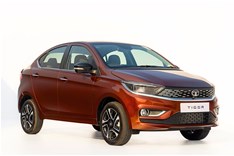

Comments
Member Login
Personal Details
No comments yet. Be the first to comment.